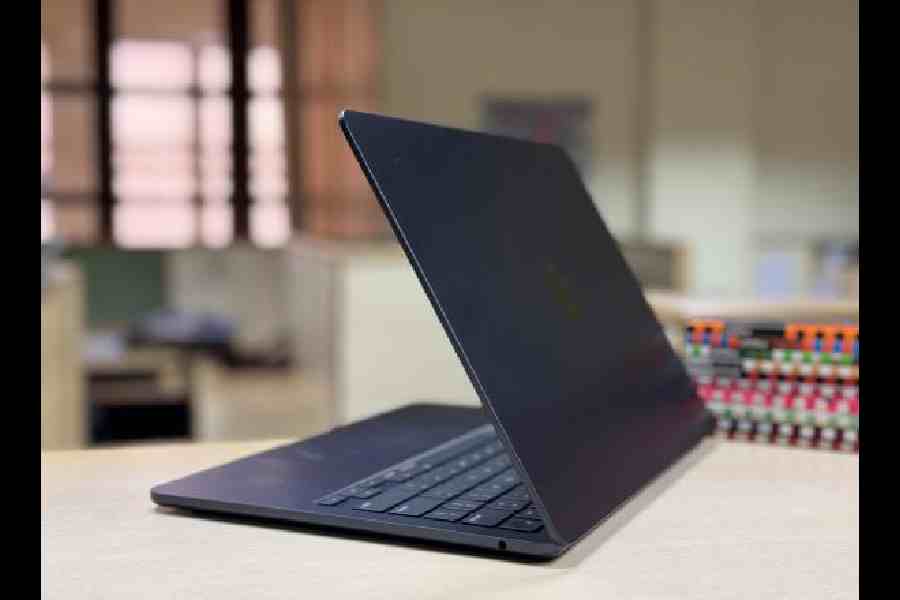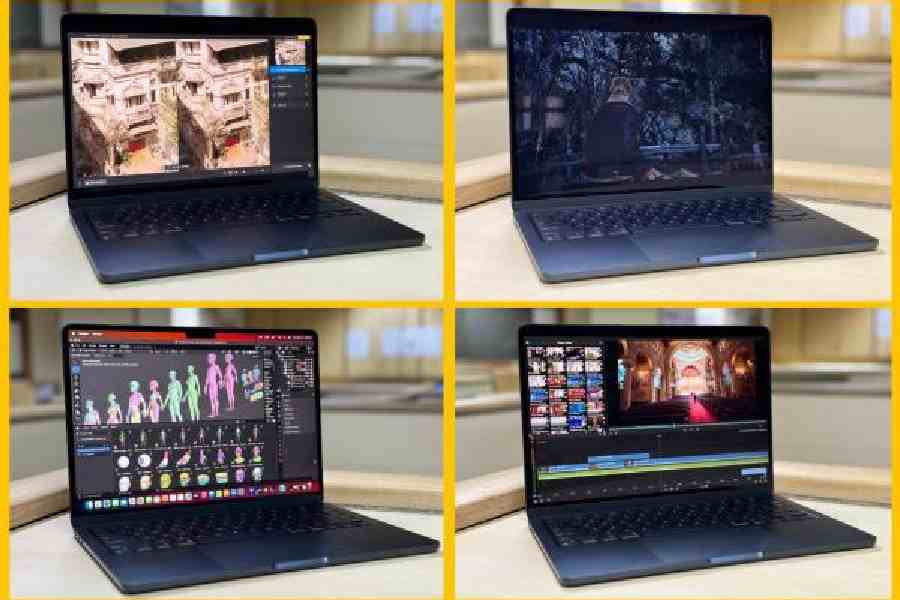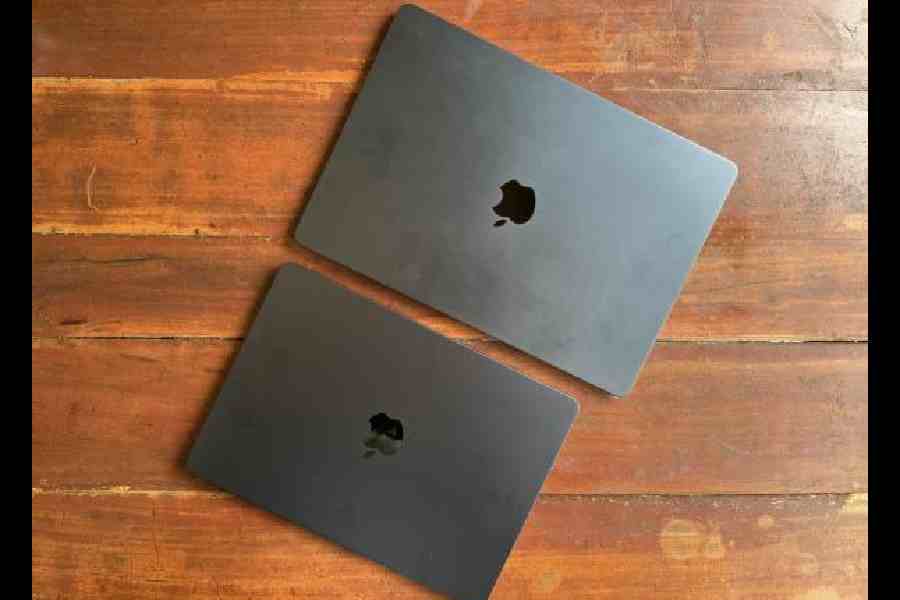When does spring begin? For a tech enthusiast, it began with the arrival of the M3 MacBook Air. Like in any good romance novel, there’s something for everyone, complete with clarity around a feature set that distinguishes it from the MacBook Pro and a certain degree of high-wire act that makes it a machine perfect for most users.
The new MacBook Air comes with Apple’s latest M3 silicon and that is the big change here from the M2 13-inch that rolled out in 2022 and the 15-inch that was introduced in 2023. The overall design hasn’t changed, keeping the machines simple, elegant and clean.

The keyboard on the MacBook offers unparalleled ease of typing
Generally speaking, the M2 MacBook Air was already pretty great even well into its second year, so while the M3 is better than the M2, it’s the difference between the M3 Air and the M1 Air as well as the Intel-based MacBook Air that is dramatic.
Since the updates are all in terms of performance, the suggestion is to choose wisely when it comes to the variant. First, there is the 13-inch model as well as the 15-inch option (helpful if you want to do some degree of gaming). For review, we have the former. The base 13-inch M3 Air has an eight-core CPU, eight-core GPU, eight gigs of memory and 256 gigs of SSD storage but if you are looking for a workflow that’s slightly demanding, I would suggest the 16GB version with 512GB SSD and it comes with an eight-core CPU but a 10-core GPU. And that’s the model we are reviewing. Let’s dive in.
Multi-monitor support
If you own a MacBook Air, you already know this: It only supports one external display. Now, there is support for two external monitors. This offers some flexibility to power users and small business users. Having multiple displays for multitasking across apps or spreading out documents at the same time is a helpful feature.
There is a caveat. Plug one monitor in and it works immediately. Then plug the other monitor into the USB-C ports on the side. To make the second display work, you need to make the Air go into clamshell mode. Overall, it’s a move in a positive direction.

Despite all its power, MacBook Air M3 remains slim and light
Staying on with the screen, the 13.6-inch Liquid Retina display with True Tone is as gorgeous as ever, complete with 500 nits of brightness. Colours look outstanding and it’s great for any colour-critical work or for viewing content. While you get a higher refresh rate, slightly deeper blacks and better contrast on the mini-LED backlit displays in the Pro models, the Air still looks great. It has very deep blacks and high contrast.
If I happen to be editing videos on the M3 Air, I can trust that what I’m going to see on the screen is going to look similar to other Apple devices, like iPhones or iPads.
It’s all about performance
Apple is claiming that the M3 MacBook Air is the world’s best consumer laptop for AI. What does that mean?
The M3 has a faster and more efficient 16-core neural engine that provides big gains to boost on-device machine learning which translates into faster AI performance across the board on the computer.
For my testing on a small scale, things like dictation and native language processing are very powerful on this computer. The performance is also translating well for local creative and productivity AI tasks that leverage the neural engine. For example, what may take 40-odd seconds to denoise a photo on Topaz Photo AI on an M1 machine is taking 10-odd seconds on the new M3 MacBook Air.

Four different heavy-duty tasks on the MacBook Air M3 (clockwise from top left): Photo editing using Topaz Photo AI, playing Resident Evil 4, video editing on Luma Fusion and checking out a VFX model on Blender
The M series chips have been crushing it for the last three years in terms of performance and now that we’re getting a neural engine that is more capable at AI-related task processing with the M3 chip, it isn’t really a far cry for Apple to say that this is the best out there for a consumer laptop when it comes to AI tasks.
Honestly, it is tough to come across an ultra-thin Windows computer with 18 hours of battery life, with impressive performance across productivity and creative tasks paired with a neural engine that can speed up local AI tasks.
Apple has been rumoured to be making their own big advancements on the AI front but, officially, we haven’t heard anything yet because that’s the Apple way of working… we don’t get to know anything until it’s ready and perfected.
This M3 chip is worth your time, especially when it comes to anything that’s related to graphics. In Blender, you can open a simple project while rendering things faster than on the M2 Air. It is only when you have a bulk load of assets that you would like to go for the faster M3 Pro.
For gaming, anything from Apple Arcade is going to run fine on this machine. Even games like No Man’s Sky or Resident Evil 4, things go at a buttery-smooth pace with acceptable frame rates. But where the GPU is going to make the biggest difference for me is with creative apps that I use everyday. Things like Lightroom and LumaFusion work perfectly. Sure, I don’t use plenty of effects in videos but the rendering is quite fast.
Instead of things like Blender, your workflow may involve using office-related software. Be it Slack, multiple tabs on the browser or using a complicated VPN to access the office network remotely, all this is possible without snags. You’re never going to feel any slowness with that kind of stuff.
Or take the example of coding. You can get it done on the M3 MacBook Air. It’s snappy and working on mobile and web projects doesn’t feel any different. Only if you are working on a huge project that takes an absurd amount of time to build, you would probably notice the performance difference there.
All this and more with a fanless design. Once again, the GPU is probably the biggest upgrade that you’re going to find on this Mac over the previous generation. The M3 series chips offer excellent hardware-enabled ray tracing and dynamic caching and provided you’re using apps that are optimised to take advantage of it, you’re going to see big leaps in performance.
I know it can be easy to get hung up in specs with these machines. There’s a disparity between chips but in reality, you’ll not notice them. The M3 Air has 100GB/s memory bandwidth, which is down from 150 in the M3 Pro and 300/400 in the M3 Max. I’ve never heard of this being a bottleneck and for context, even the best PC builds are below 100, so the M3 still has a crazy amount of bandwidth.
Coming back to AI, it will remain a big part of our lives. Sure, Microsoft has been making a serious push in AI and Nvidia is emerging as a big player in AI technology. But what Apple has done with its silicone is highly impressive.
The not-so-little things
What doesn’t get enough attention is the wireless connectivity on the M3. It got bumped up from Wi-Fi 6 to 6E and provided you have a fast Internet connection and Wi-Fi 6E capable router, there’s a pretty dramatic increase in network speed. For many of us our network speed is probably the bottleneck that affects us the most, so any big gains that we can get there can have a huge impact on productivity.
Equally impactful for most of us is battery life and like the rest of the Mac lineup this is outstanding. Apple says you’re going to get up to 18 hours of battery on the M3 Air. With a combination of web browsing, listening to music, watching content and renders, I made it through two full days of use. If you run your system at full throttle, it’s not going to last nearly as long. Still, you can get at least a day out of it.
Portability wise, the 13-inch is much easier to move around, I can throw it in the bag and just run out the door but I’m not going to knock the 15-inch MacBook Air too much. We’ve waited a long time for Apple to get a big-screen consumer laptop and I think for some users it’s going to be a good option.
Should you buy it?
There’s one change I would like to see: One of the USB-C ports can be moved from the left to the right, making it easy to plug in cables that are not too long.
Now we come to the other things. The 13-inch MacBook Air has a four-speaker sound system that consists of two tweeters and two woofers. On the 15-inch model you get a six-speaker sound system. Yet, both machines sound great. Also, the machine retains a 3.5mm headphone jack despite being slim. The webcam too is suitable for using over a long time — 1080p FaceTime HD camera.

MacBook Air M3 (13 inch) versus MacBook Air M2 (15 inch)
Besides being faster than before, the 13-inch MacBook Air is simply a great machine to use, despite not having a ProMotion mini-LED display. Let me not even get into the keyboard and trackpad. It’s the best money can buy — highly responsive and you can key in a long article without breaking into a sweat.
After years of upgrades and tweaks, the MacBook Air has reached a level of perfection. With enough power, the fanless MacBook Air with M3 does something we all deserve — trims headaches, boosts productivity.











